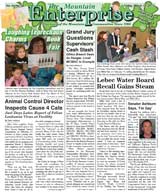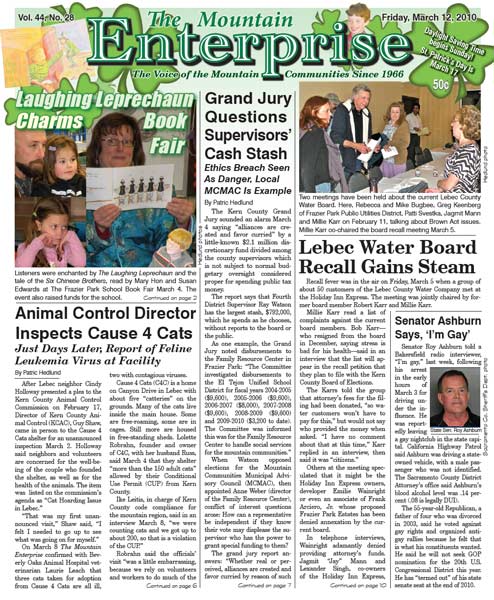Just Days Later, Report of Feline Leukemia Virus at Facility
By Patric Hedlund
After Lebec neighbor Cindy Holloway presented a plea to the Kern County Animal Control Commission on February 17, Director of Kern County Animal Control (KCAC), Guy Shaw, came in person to the Cause 4 Cats shelter for an unannounced inspection March 2. Holloway said neighbors and volunteers are concerned for the well-being of the couple who founded the shelter, as well as for the health of the animals. The item was listed on the commission’s agenda as “Cat Hoarding Issue in Lebec.”
“That was my first unannounced visit,” Shaw said, “I felt I needed to go up to see what was going on for myself.”
On March 8 The Mountain Enterprise confirmed with Beverly Oaks Animal Hospital veterinarian Laurie Leach that three cats taken for adoption from Cause 4 Cats are all ill, two with contagious viruses.
Cause 4 Cats (C4C) is a home on Canyon Drive in Lebec with about five “catteries” on the grounds. Many of the cats live inside the main house. Some are free-roaming, some are in cages. Still more are housed in free-standing sheds. Lolette Robrahn, founder and owner of C4C, with her husband Russ, said March 4 that they shelter “more than the 150 adult cats” allowed by their Conditional Use Permit (CUP) from Kern County.
Ike Leitis, in charge of Kern County code compliance for the mountain region, said in an interview March 8, “we were counting cats and we got up to about 200, so that is a violation of the CUP.”
Robrahn said the officials’ visit “was a little embarrassing, because we rely on volunteers and workers to do much of the cleaning, and they set their own hours; most hadn’t been there yet when [Shaw and his staff] came.”
Robrahn explained that her own duties are mainly to feed, water and provide medication to the cats. She said Shaw told her KCAC wants clean-up to start earlier in the day, “at 8 a.m.” In an interview Thursday, March 4, Shaw said “We would like [clean-up] to be continual.”
Shaw also confirmed he recommended that Cause 4 Cats rearrange use of the home’s interior space,
“We want to see her reduce the number [of cats within the house] because the way the cats are in the house is detrimental to humans and to the cats—so we want her to organize better within the house.” He suggested that there be separation between the people’s living space and the areas in which the cats are allowed to roam.
Highly Contagious
Shaw was not aware at the time of his visit that two cats sent for adoption by C4C were diagnosed last week with the feline leukemia retrovirus (FeLV) and Feline immunodeficiency virus FIV.
Of three cats taken from C4C last month for adoption, “a beautiful little Siamese kitty” named Loretta tested positive for the highly contagious FeLV and subsequently feline peritonitis.
FeLV causes feline leukemia and many other illnesses. Cats that roam freely are likely to infect each other through saliva. Patrice Stimpson, who was trained as a humane officer, said FeLV is “a terrible disease that is highly contagious and transmitted through shared litter boxes, dishes and water bowls….” Loretta had to be euthanized March 7.
The second cat, Big Red, a large orange male, tested positive for FIV (feline immunosuppresive virus) with enlarged kidneys and liver. He is being treated with interferon and will have a CT scan this week, Dr. Leach said.
Robrahn said that the FIV is mainly spread by fighting between unneutered male cats and that she does not maintain aggressive cats in their facility. She said that Big Red was not neutered when he came in and that it is likely he was infected before he came, “that is not a worry here,” she said.
The third cat has an elevated temperature with upper respiratory infection. It is being treated and held for observation.
Adrienne Hagan of Cat Connection, an animal rescue associated with the Beverly Oaks Animal Hospital in Sherman Oaks, estimates they have placed about 5,000 cats in adoptive homes since 1996. She, like most animal rescue people we talked with for this story, is concerned. “We stopped working with Cause 4 Cats when [Robrahn] got careless with medical care for the animals,” Hagan said.
Animal rescue workers have contacted us to report that C4C has not been isolating new cats as they come into the facility to observe them for 14 days and to give vaccinations and tests for communicable diseases prior to being allowed to associate with other cats.
When asked to comment about this, Robrahn says she is not taking any new cats in at this time, but that she does isolate, vaccinate and "spot test sick-looking cats" with a $10 Assure test for FeLV. Not all cats with the FeLV virus look sick, but they may be “silent carriers” that can infect other cats. The Assure kit tests saliva rather than blood and is said to yield more false results.
In the past, Robrahn said, new cats “were always put in large dog crates and I make sure they are fully vaccinated. It takes three weeks.”
We asked, ‘Have all cats there gone through three week isolation?’ She said “yes.” People who have helped at the facility recently said that is not true.
Robrahn denied that FeLV is a factor, “that is not a threat in our cattery,” she said.
Kennel Permit
Shaw said that an ordinance passed by the Kern County Board of Supervisors in February will require that Cause 4 Cats apply for a permit as a commercial kennel.
Robrahn “needs to get her application in so we can permit her and so she can meet whatever code compliance requires her to do. We will be visiting her and she will need to continue to meet the requirements of her permit,” Shaw said.
Help Requested
Robrahn said she has been touched by donations that have come in the mail and by new volunteers that are coming to help. Robrahn’s number is 248-0299 if you would like to volunteer.
This is part of the March 12, 2010 online edition of The Mountain Enterprise.
Have an opinion on this matter? We'd like to hear from you.


